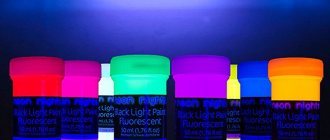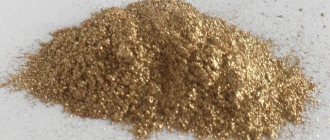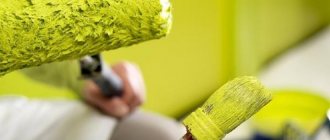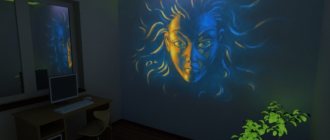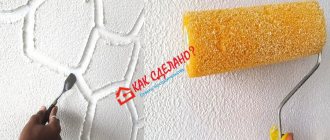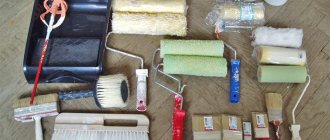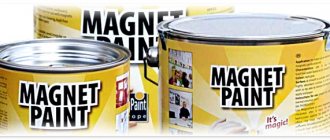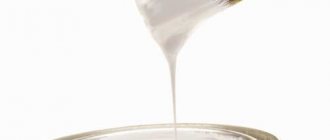- September 23, 2018
- Terms
- Katerina Belokon
Nowadays, people try to be original and inventive in order to stand out from the rest. This can equally apply to their appearance, hobbies, or even the interior of the apartment. A very interesting fact is that you can succeed in all of the above areas with the help of paint that glows in the dark.
What is it and how does it work
Glow in the dark paint is a specific type of paint that has special characteristics. The thing is that it can glow on its own in absolute darkness, without having any power source. This is possible due to the fact that the paint accumulates the required amount of energy when exposed to light. As a result of this, it can emit light on its own for a long period of time.
Sometimes it happens that buyers do not know the correct name for paint that glows in the dark. Luckily for her, there are many titles, with the following being the most popular:
- phosphor;
- luminescent;
- light accumulative;
- self-luminous.
How to make glowing paint from phosphor powder?
You can make paint with a glow effect with your own hands. To do this, you need to buy a phosphor, select a transparent varnish and a solvent for it. You will also need ceramic or glass dishes for mixing the ingredients.
The phosphor of the desired color can be found on the Internet or a building materials store. It is quite expensive, but 100 g of this powder is enough to completely color about 8 square meters. m of surface. The price depends on the color of the glow: pigments in light green, blue and white shades are cheaper, but brighter ones - red, orange, blue, green - are more expensive.
Phosphor - luminous powder for making luminescent paint
Important! The varnish should be chosen according to the surface that will be painted. This is the only way the finished paint will adhere well.
How to make glowing paint at home:
- Pour varnish into the dishes.
- Add powdered phosphor (the ideal ratio is when the composition consists of 70% varnish and 30% luminous pigment).
- Add a little solvent to the mixture (up to 1% of the total mass).
- Stir thoroughly.
- If you need to get a colored composition, color is also added to the dishes.
Materials and tools necessary for preparing luminescent paint
Paint made in this way is used and stored in the same way as regular varnish of a similar type.
Compound
It’s worth immediately drawing your attention to the fact that this paint has nothing to do with phosphorus, the main feature of which is the emission of light in the dark. You also need to understand that the composition of this coating does not contain any substances harmful to human health.
It is worth mentioning that a substance with similar properties was an object of desire back in ancient times. Despite the fact that people then did not know what glow-in-the-dark paints were called, they still managed to achieve the desired result, but with the use of harmful and dangerous components.
Today, the main property of this substance is possible thanks to the action of a luminescent pigment, which is also known as a phosphor. In itself, it is a powder that is capable of accumulating light radiation. The paint itself is obtained by mixing this powder with a transparent base, which is often acrylic.
You can make the paint glow in different colors by adding fluorescent fillers to its composition. As a result, the paint will emit the following colors:
- blue;
- violet;
- green;
- red;
- yellow.
Scope of application
Considering the fact that there are many names for paint that glows in the dark, it is not surprising that it has a very wide range of applications. Due to its unique properties, this substance can be found in the following areas of application:
- Interior Design. This paint is a very popular material for decorating clubs and restaurants, applying certain images to walls, ceilings and even floors. In residential areas, such paint is used quite rarely, since it is impossible to achieve complete darkness, which may sometimes be required for a restful and restful sleep.
- Body art. The harmless paint allows you to apply luminous makeup and manicure.
- Textile. Dye is applied to clothing and shoes either for advertising purposes or to make the products unique. It can remain on textiles even after 50 washes.
- Printing. Production of advertising products that would be visible in the dark.
- Tuning. You can use paint to customize cars, motorcycles and even bicycles.
Modern electroluminescent paint LumiLor for car tuning
LumiLor electroluminescent coating is used to emit light by supplying electricity. The developers managed to create a coating based on the electroluminescence process. The mechanism of action is based on the fact that radiative recombination occurs at the subatomic level, due to which phosphorescent substances emit photons of light under the influence of an electric current. Thanks to these processes, when electricity is supplied, the paint begins to glow in a predetermined color.
A car painted with luminescent paint glows at night
Basic colors of LumiLor paint:
- red;
- blue;
- green;
- white;
- yellow.
All other shades are obtained by mixing these primary colors using a color toner.
Features of electroluminescent paint
Interestingly, in the absence of power supply, the painted surface looks absolutely normal. However, under the influence of electric current the coating begins to glow. All this creates huge possibilities for creativity, since now the car body can actually be made into a canvas. On it you can depict various original drawings made by yourself.
LumiLor operates on AC power with a frequency of 500 to 1000 Hz. To connect you need to use a 12V inverter. It is enough to connect any energy source to this inverter, from batteries to a 220 V network.
Application rules
LumiLor can be applied to any type of surface, such as plastic, metal, wood or fiberglass. Before application, the metal must be pre-primed and insulated. Electroluminescent paint should be coated with a transparent varnish, the thickness and type of which is selected taking into account the operating conditions. The material can be applied to any surface that is in the car, both in the exterior and interior. For example, this paint can be used to paint metal, plastic, glass, wooden elements and even carbon fiber. Thanks to this, you can make an individual and original drawing in your car with your own hands, which will shine in any situation. According to the developers, the electroluminescent coating is sealed and waterproof.
The DIY method of applying LumiLor electroluminescent paint requires the use of certain equipment and professional skills. However, despite this, the use of electroluminescent coating in the field of car tuning is becoming increasingly popular.
Variety
All these paints can be classified according to the type of active substance. So, the following options are available:
- Fluorescent paint. Its characteristic feature is that it can study light only under the influence of ultraviolet rays. So, if you've ever wondered whether fluorescent paint glows in the dark or not, now you know for sure that it requires certain conditions in the form of UV radiation. As mentioned above, this paint can glow in different colors.
- Luminescent paint. In the dark, it gives off accumulated sunlight or artificial light. To fully “recharge” it takes about 15 minutes of light exposure.
- Reflective paint has a composition that allows it to glow only when light hits it. That is why it is actively used for road markings and the production of road signs.
Further, such paints can also be classified according to their degree of transparency:
- Translucent. They are distinguished by the fact that in daylight they are almost impossible to notice. In the dark, they emit blue or green light.
- Colored. They are easy to see in daylight and emit light equally well in complete darkness or when exposed to UV rays.
The best manufacturers of ready-made dye
Popular manufacturers of luminous paints and varnishes include:
- Vesta, offering waterproof paints that are resistant to low temperatures. The materials are supplied packaged in jars with a capacity of 50 ml, the stated service life is 50 years. Professional series enamels are intended for artistic or decorative works; they have good adhesion to paper, canvas, metal and finishing materials. The layer applied to the surface in daylight has a rich shade (compared to standard enamels). Glow in the dark time is up to 8 hours.
- G-Color, which produces acrylic photoluminescent paints in 250 ml aerosol cans. The materials emit a glow visible in the dark (working time up to 10-12 hours); when using ultraviolet illumination, the intensity increases.
- Acid Colors, which produces paints and varnishes based on phosphor-free phosphor pigments. The manufacturer claims a glow-in-the-dark time of 6 hours; after short-term irradiation with an incandescent lamp, performance is restored. The acrylic base, after polymerization, has increased strength and can withstand exposure to water. Paints are supplied to customers in 27 ml plastic bottles.
- Noxton, offering ready-made paints and ultraviolet pigments of the TAT-33 series (25 shades). The Noxton Ultraviolet enamels series is available in 18 standard colors; the materials are resistant to fading. The advantage is the availability of international certificates. Paints are supplied to customers in Europe, North America and the Middle East.
- Proluminofor, which supplies dry pigments to the market (packed in 20 or 100 g or 1 kg). The materials are finely ground (particle size from 5 microns), the manufacturer claims a glow time of 6 to 12 hours. Low-cost powders on a colored sulfide base are offered, and heat-resistant pigments are produced.
Vesta fluorescent acrylic paint.
Application Tips
In order to achieve the maximum effect from such paint, you need to know how to apply it correctly. First of all, it is worth noting that the ideal base is a flat white surface. When applying such coatings to a dark coating, you need to understand that the black color itself absorbs a significant part of the light, thereby taking away the brightness from the luminous paint. If you cannot change the color of the surface, then it is recommended to treat it with a primer before painting.
Before starting work, the paint itself must be thoroughly mixed, since luminous elements may settle to the bottom of the can over time. Regardless of color, the surface must be clean and dry. The painting itself must be carried out in two layers, and the second can be applied only after the first has completely dried.
Recommendations for use
It is better if the base on which the paint is applied is white. The black surface itself absorbs a large amount of light, so the phosphors receive less energy, and the glow will be weak.
Surface preparation
Before applying the finish, the base is cleaned of dust, grease stains, previous cladding, and fungus. It should be smooth and dry. To improve adhesion, the walls are treated with a primer. If necessary, the base is puttied.
Coloring
To paint a room with your own hands, you need to ensure good ventilation. Work is carried out wearing gloves, safety glasses and special clothing.
Painting involves the following steps:
- Applying the first layer. To do this, use a brush, rollers or spray.
- Applying the second layer. The previous coating must be completely dry.
To protect the finish from the negative influence of external factors in the room, it is coated with transparent varnish.
When painting, it is necessary to ensure good ventilation.
How to make it yourself
After we have figured out what the name of the paint that glows in the dark is, what types there are and how to apply it correctly, we can mention that you can make it yourself. To do this, you will need varnish, a solvent, suitable containers (glass or ceramic), and the phosphor itself. The manufacturing process consists of three simple steps:
- Pour the varnish into the container.
- Pour in the powder (the more you pour in, the brighter your paint will be, but the standard ratio is 1:3).
- Add 1% solvent to evenly distribute the luminous substance and mix.
This is a recipe for making transparent enamel. If you want to give your paint a certain color, then you still need to add the dye you need to the above composition.
Making your own phosphor
If you really want to, you can make your own phosphor. True, this will require more effort and special reagents. What do we have to do:
- Take pine concentrate and dissolve it in clean water in a ratio of 1:50. The finished solution should have a yellow tint.
- Pour 2-3 g of boric acid into a heat-resistant bowl with a wide bottom.
- Place about 10 drops of pine solution on the powder.
Coniferous concentrate is the main component that affects the glow of homemade phosphorOn a note! The color and intensity of the glow of the resulting phosphor will depend on the concentration of the pine extract. Therefore, it can be varied to achieve the desired effect.
- Mix the resulting mixture thoroughly and level it over the bottom of the dish in a layer no thicker than 4 mm.
- Place the dishes on the electric stove and dry over low heat.
- After the water evaporates, the mixture will begin to melt and bubbles will appear on its surface. They should be pierced.
- When the mixture is completely melted, it must be removed from the stove and left at room temperature until it cools completely.
- Grind the frozen crust into powder. This will be the phosphor, which can already be mixed with transparent varnish and used for its intended purpose.
Before making a phosphor, you should calculate the required volume of luminous paint. It is quite possible that it will be easier and cheaper to buy ready-made material in a store. In addition, “branded” paint will always be of higher quality than artisanal paint, and the color of the glow can be selected immediately, without lengthy experiments. And having one or several jars of luminescent paint in your arsenal, it’s easy to create an unusual thing, stylish tuning or a unique interior.
